
Concept explainers
(a)
Interpretation:
The IUPAC name for the compound is to be stated.
Concept introduction:
The systematic naming of organic compound is given by
Rules for writing IUPAC name from structural formula are shown below.
• First identify the longest carbon chain.
• The next step is to identify the groups attached to the longest chain.
• Identify the position, location, and number of the substituents bonded to the carbon chain.
• Use prefix di, tri, tetra if same type of substituents are present.
• Name the substituents in alphabetical order.
Answer to Problem 12.4E
The name of compound is
Explanation of Solution
The compound is given as

Figure 1
Therefore, the name of the compound is
The name of compound is
(b)
Interpretation:
The IUPAC name for compound is to be stated.
Concept introduction:
The systematic naming of organic compound is given by IUPAC nomenclature. The naming of organic compound is done such that the structure of organic compound is correctly interpreted from the name.
Rules for writing IUPAC name from structural formula are shown below.
• First identify the longest carbon chain.
• The next step is to identify the groups attached to the longest chain.
• Identify the position, location, and number of the substituents bonded to the carbon chain.
• Use prefix di, tri, tetra if same type of substituents are present.
• Name the substituents in alphabetical order.
Answer to Problem 12.4E
The name of the given compound is
Explanation of Solution
The compound is given as shown below.

Figure 2
The parent chain is pentene, that is, it consists of five carbon atoms and a double bond between the second and the third carbon atoms. An ethyl group is present as a substituent on the third carbon atom as shown below.
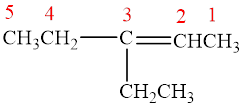
Figure 3
Therefore, the name of compound is
The name of compound is
(c)
Interpretation:
The IUPAC name for the given compound is to be stated.
Concept introduction:
The systematic naming of organic compound is given by IUPAC nomenclature. The naming of organic compound is done such that the structure of organic compound is correctly interpreted from the name.
Rules for writing IUPAC name from structural formula are shown below.
• First identify the longest carbon chain.
• The next step is to identify the groups attached to the longest chain.
• Identify the position, location, and number of the substituents bonded to the carbon chain.
• Use prefix di, tri, tetra if same type of substituents are present.
• Name the substituents in alphabetical order.
Answer to Problem 12.4E
The name of compound is
Explanation of Solution
The compound is given as shown below.

Figure 4
The parent chain is hexyne, that is, it consists of six carbon atoms and a triple bond between the second and the third carbon atoms. Two methyl groups are present as a substituent on the fourth carbon atom as shown below.
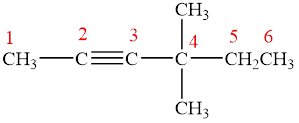
Figure 5
Therefore, the name of compound is
The name of compound is
(d)
Interpretation:
The IUPAC name for the given compound is to be stated.
Concept introduction:
The systematic naming of organic compound is given by IUPAC nomenclature. The naming of organic compound is done such that the structure of organic compound is correctly interpreted from the name.
Rules for writing IUPAC name from structural formula are shown below.
• First identify the longest carbon chain.
• The next step is to identify the groups attached to the longest chain.
• Identify the position, location, and number of the substituents bonded to the carbon chain.
• Use prefix di, tri, tetra if same type of substituents are present.
• Name the substituents in alphabetical order.
Answer to Problem 12.4E
The name of compound is
Explanation of Solution
The compound is given as shown below.

Figure 6
The parent chain is cyclopentene, that is, it consists of five carbon atoms in a ring and a double bond between the first and the second carbon atoms. A methyl group is present as a substituent on the fourth carbon atom as shown below.
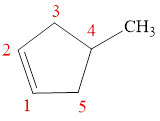
Figure 7
Therefore, the name of compound is
The name of compound is
(e)
Interpretation:
The IUPAC name for compound is to be stated.
Concept introduction:
The systematic naming of organic compound is given by IUPAC nomenclature. The naming of organic compound is done such that the structure of organic compound is correctly interpreted from the name.
Rules for writing IUPAC name from structural formula are shown below.
• First identify the longest carbon chain.
• The next step is to identify the groups attached to the longest chain.
• Identify the position, location, and number of the substituents bonded to the carbon chain.
• Use prefix di, tri, tetra if same type of substituents are present.
• Name the substituents in alphabetical order.
Answer to Problem 12.4E
The name of compound is
Explanation of Solution
The compound is given as shown below.
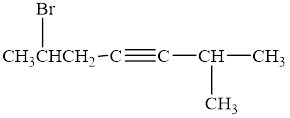
Figure 8
The parent chain is heptyne, that is, it consists of seven carbon atoms and a triple bond between the third and the fourth carbon atoms. A methyl group and a bromine group are present as substituents on the second and the sixth carbon atoms respectively as shown below.
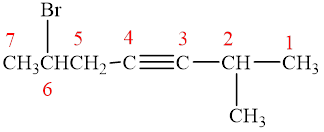
Figure 9
Therefore, the name of the given compound is
The name of compound is
(f)
Interpretation:
The IUPAC name for the given compound is to be stated.
Concept introduction:
The systematic naming of organic compound is given by IUPAC nomenclature. The naming of organic compound is done such that the structure of organic compound is correctly interpreted from the name.
Rules for writing IUPAC name from structural formula are shown below.
• First identify the longest carbon chain.
• The next step is to identify the groups attached to the longest chain.
• Identify the position, location, and number of the substituents bonded to the carbon chain.
• Use prefix di, tri, tetra if same type of substituents are present.
• Name the substituents in alphabetical order.
Answer to Problem 12.4E
The name of compound is
Explanation of Solution
The compound is given as shown below.
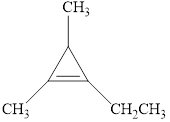
Figure 10
The parent chain is cyclopropene, that is, it consists of three carbon atoms and a double bond between the first and the second carbon atoms. An ethyl group and two methyl groups are present as a substituent on the first, second and the third carbon atoms respectively as shown below.
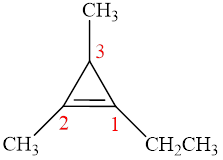
Figure 11
Therefore, the name of compound is
The name of compound is
(g)
Interpretation:
The IUPAC name for compound is to be stated.
Concept introduction:
The systematic naming of organic compound is given by IUPAC nomenclature. The naming of organic compound is done such that the structure of organic compound is correctly interpreted from the name.
Rules for writing IUPAC name from structural formula are shown below.
• First identify the longest carbon chain.
• The next step is to identify the groups attached to the longest chain.
• Identify the position, location, and number of the substituents bonded to the carbon chain.
• Use prefix di, tri, tetra if same type of substituents are present.
• Name the substituents in alphabetical order.
Answer to Problem 12.4E
The name of compound is
Explanation of Solution
The compound is given as shown below.

Figure 12
The parent chain is heptadiene, that is, it consists of seven carbon atoms and double bonds between the first, second and the fourth, fifth carbon atoms. A methyl group is present as a substituent on the sixth carbon atom as shown below.

Figure 13
Therefore, the name of compound is
The name of compound is
Want to see more full solutions like this?
Chapter 12 Solutions
Chemistry for Today: General Organic and Biochemistry
- Draw the product of the reaction shown below. Ignore small byproducts that would evaporate pleasearrow_forwardPoly(ethylene adipate) is a biodegradable polyester (shown below). Identify the type of polymerization process used in the production of this polymer.arrow_forwardPolymers may be composed of thousands of monomers. draw two repeat units(dimer) of the polymer formed in this reaction. assume there are hydrogen atoms on the two ends of the dimer. ignore inorganic byproducts pleasearrow_forward
- Draw the product of the reaction shown below. Use a dash or wedge bond to indicate stereochemistry of substituents on asymmetric centers, Ignore inorganic byproductsarrow_forwardDraw the product of this reaction please. Ignore inorganic byproductsarrow_forwardOne of the pi molecular orbitals of 1,3-butadiene (CH2=CHCH=CH2) is shown below. Please identify the number of nodal planes perpendicular to the bonding axisarrow_forward
- Draw the monomers required to synthesize this condensation polymer please.arrow_forwardProvide the correct systematic name for the compound shown here. Please take into account the keyboard options belowarrow_forwardcurved arrows are used to illustrate the flow of electrons. using the provided starting and product structures, draw the curved electron-pushing arrows for the following reaction or mechanistic step(s)arrow_forward
- Identify the 'cartoon' drawing of the acceptor orbital in the first mechanistic step of an electrophilic addition reaction of butadiene with HBr. Pleasearrow_forwardH- H H H H H H Identify and select all structures below that represent a constitutional isomer(s) of the compound shown above. H- H H H A. H H H H-C CI H H D. H H H H H H C C -H H C C H H H H B. H CI H H- C C H H H H E. H CI H C.arrow_forwardWhy doesn't this carry on to form a ring by deprotonating the alpha carbon and the negatively-charged carbon attacking the C=O?arrow_forward
- Chemistry: Matter and ChangeChemistryISBN:9780078746376Author:Dinah Zike, Laurel Dingrando, Nicholas Hainen, Cheryl WistromPublisher:Glencoe/McGraw-Hill School Pub Co
 Chemistry for Today: General, Organic, and Bioche...ChemistryISBN:9781305960060Author:Spencer L. Seager, Michael R. Slabaugh, Maren S. HansenPublisher:Cengage Learning
Chemistry for Today: General, Organic, and Bioche...ChemistryISBN:9781305960060Author:Spencer L. Seager, Michael R. Slabaugh, Maren S. HansenPublisher:Cengage Learning

